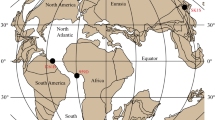Abstract
Maximum entropy spectral analysis and multidimensional cross-spectral analysis are two important tools for studying periodicity of elemental sedimentation in strata. They are applied to the study of the Devonian lensoid limestone formation in the Nandan-Hechi basin of Guangxi, China. Results show that all major element oxides of the sedimentary formation display a consistent change period of about 4 m; however, elements do not change in step. Nonlinear geochemical dynamic processes of elemental sedimentation through sea-floor fluids may be effectively reconstructed based on power spectral analyses.
Similar content being viewed by others

REFERENCES
Ables, J. G., 1974, Maximum entropy spectral analysis: Astron. Astrophys. Suppl. Series, v. 15, p. 383–393.
Agterberg, F. P., and Banerjee, I., 1969, Stochastic model for the deposition of varves in glacial lake Barlow-Ojibway, Ontario, Canada: Can. Jour. Earth Sci., v. 6. p. 625–652.
Agterberg, F. P., 1974, Geomathematics: Mathematical background and geoscience applications: Elsevier Publ. Co., Amsterdam, 596 p.
Akaike, H., 1970, Statistical predictor identification: Ann. Inst. Statist. Math., v. 22, p. 203–217.
Anderson, M., 1974, On the calculation of filter coefficients for maximum entropy analysis: Geophysics, v. 39, p. 69–72.
Anderson, R. Y., and Koopman, L. H., 1963, Harmonic analysis of varve time series: Jour. Geophys. Res., v. 68, p. 877–893.
Bingham, C., Godfrey, M. D., and Tukey, J. W., 1967, Modern techniques of power spectrum estimation: IEEE Trans. Audio and Electroacoust., vol. AU-15, p. 56–66.
Burg, J. P., 1967, Maximum entropy spectral analysis: Proceedings of the 37th Annual Internat'l. meeting, Soc. of Explor. Geophys. Oklahoma (USA).
Burg, J. P., 1968, A new analysis technique for time series data: presented at the Advanced Study Institute on Signal Processing, NATO, Enschede, Netherlands.
Chen, W. Y., and Stegen, G. R., 1974, Experiments with maximum entropy power spectra of sinusoid: Jour. Geophys. Res., v. 79, p. 3019–3022.
Chen, X. P., Gao, J. Y., Zhang, G. X., and Chen, F., 1985, Sedimentary geochemical characteristics of Devonian strata-bound polymetal deposits in South China: Scientia Sinica, p. 101–112.
Childers, D. G., 1978, Introduction, in D. C. Childers, ed.: Modern Spectrum Analysis: IEEE Press, New York, p. 1–5.
Cryer, J. D., 1985, time series analysis: Duxbury Press, Boston, 286 p.
Davis, J. C., 1986, Statistics and data analysis in geology: John Wiley, New York, 2nd ed., 646 p.
Dean, W. E., and Anderson, R. Y., 1974, Application of some correlation coefficient techniques to time-series analysis: Jour. Math. Geol., v. 6, p. 363–372.
Geol. Bureau of Guangxi, 1968, Geological map of Nandan Area (1/200000) and its guide (unpublished).
Gutowski, P. R., Robinson, E. A., and Treitel, S., 1978, Spectral estimation: Fact or fiction: IEEE Trans. Geosci. Electron., vol. GE-16, p. 80–84.
Hay, W. W., and Southam, J. R., 1978; Quantifying biostratigraphic correlation: Ann. Rev. Earth Planet. Sci., v. 6, p. 353–375.
Koopmans, L. H., 1967, A comparison of coherence and correlation as measures of association for time or spatially indexed data: Kans. Geol. Survey., Comput. Contrib., v. 18, p. 1–4.
Lacos, R. T., 1971, Data adaptive spectral analysis methods: Geophysics, v. 36, no. 4, p. 661–676.
Luo, C. L., 1980, An introduction to maximum entropy spectral analysis (in Chinese): Practices and Recognization of Mathematics, No. 1, p. 1–18.
McDonough, R. N., 1974, Maximum-entropy spatial processing of array data: Geophys., v. 39, p. 843–851.
Nosal, M., and Vrbik, J., 1982, Stratigraphic analysis and the asymptotic distribution of the coefficient of cross-association: Math. Geology, v. 14, p. 11–36.
Parzen, E., 1974, Some recent advances in time series modeling: IEEE Trans. Autom. Control. vol. AC-19, p. 723–730.
Press, H. P., Flannergy, B. P., Teukolsky, S. A., and Vetterling, W. T. 1988, Numerical recipes: Cambridge University Press, New York, 818 p.
Radoski, H. R., Zawalick, E. J., and Fougere, P. F., 1976, The superiority of maximum entropy power spectrum techniques applied to geomagnetic micropulsations: Phys. of the Earth and Planetary Interiors, v. 12, p. 208–216.
Schwarzacher, W., 1975, Sedimentation models and quantitative stratigraphy: Elsevier, New York, 382 p.
Shaw, B. R., and Cubitt, J. M., 1979, Stratigraphy correlation of well logs: An automated approach, in D. Gill and D. F. Merriam ed., Geomathematical and petrophysical studies in sedimentology: Pergamon, Oxford, p. 127–148.
Shoutham, J. R., and Hay, W. W., 1978, Correlation of stratigraphic sections by continuous variables: Comput. Geosci., v. 4, p. 257–260.
Tong, H., 1977, More on autoregressive model fitting with noisy data by Akaike's information criterion: IEEE Trans. Inform. Theory, Vol. IT-23, p. 409–410.
Ulrych, T. J., and Bishop, T. N., 1975, Maximum entropy spectral analysis and autoregressive decomposition: Rev. Geophys. Space Phys. v. 13, p. 183–200.
Ulrych, T. J., 1972, Maximum entropy power spectrum of truncated sinusoid: Jour. Geophys. Res., v. 77, p. 1396–1401.
Ulrych, T. J., Smylie, D. E., Jensen, O. G., and Clarke, G. K. C., 1973, Predictive filtering and smoothing of short records by using maximum entropy: Jour. Geophys. Res. v. 78, p. 4959–4964.
van den Bos, A., 1971, Alternative interpretation of maximum entropy spectral analysis: IEEE Trans. Inform. Theory, vol. IT-17, p. 67–73.
Wang, Z. K., 1979, Stochastic theory: Science Press, Beijing, 530 p.
Yu, C.W., 1980, Mathematical geology: Methods and applications: Metallurgic Industry Press, 1150 p.
Zhou, Y. Z., Yang, W. H., and Liu, Y. M., 1994, Power spectral analysis and its applications in sedimentary elemental geochemistry: Chinese Mathematical Geology Conference Abstract Volume, Wuhan, A12–16.
Zhou, Y. Z., and Yang, W. H., 1988, Cross spectral analysis and its sedimentary geochemical implications: Bulletin of the Chinese Association for Mineralogy, Petrology and Geochemistry, no. 4, p. 223–226.
Zhou, Y. Z., 1987, Sedimentary geochemistry and geomathematical characteristics of intraplatformal basin facies strata, An anatomy of the Devonian Nandan-Hechi Basin, Southern China: unpubl. M.Sc. Thesis, Institute of Geochemistry, Chinese Academy of Sciences, 202 p.
Author information
Authors and Affiliations
Rights and permissions
About this article
Cite this article
Zhou, Y. Reconstruction of Nonlinear Geochemical Dynamics of Elemental Sedimentation Based on Power Spectral Analysis of Time Sequence. Mathematical Geology 31, 723–742 (1999). https://doi.org/10.1023/A:1007584511667
Issue Date:
DOI: https://doi.org/10.1023/A:1007584511667



